

Oxodil Pph

Ask a doctor about a prescription for Oxodil Pph

How to use Oxodil Pph
Leaflet accompanying the packaging: patient information
Oxodil PPH, 12 micrograms, powder for inhalation in a hard capsule
Formoterol fumarate dihydrate
Read the leaflet carefully before using the medicine, as it contains important information for the patient.
- Keep this leaflet, so you can read it again if you need to.
- If you have any doubts, consult your doctor or pharmacist.
- This medicine has been prescribed specifically for you. Do not pass it on to others. The medicine may harm another person, even if their symptoms are the same as yours.
- If the patient experiences any side effects, including any side effects not listed in this leaflet, they should tell their doctor or pharmacist. See section 4.
Table of contents of the leaflet
- 1. What is Oxodil PPH and what is it used for
- 2. Important information before using Oxodil PPH
- 3. How to use Oxodil PPH
- 4. Possible side effects
- 5. How to store Oxodil PPH
- 6. Contents of the packaging and other information
1. What is Oxodil PPH and what is it used for
Oxodil PPH contains a bronchodilator that makes breathing easier (selective β-adrenergic receptor agonist).
Oxodil PPH is a medicine used for the long-term treatment of moderate and severe chronic asthma in patients who require regular bronchodilator treatment in combination with long-term anti-inflammatory treatment. Corticosteroids should be used regularly.
Oxodil PPH is also indicated for the relief of bronchospasm symptoms (shortness of breath due to bronchial constriction) in patients with chronic obstructive pulmonary disease.
Oxodil PPH capsules are intended for inhalation use only.
2. Important information before using Oxodil PPH
When not to use Oxodil PPH:
- if the patient is allergic to formoterol fumarate dihydrate or any of the other ingredients of this medicine (listed in section 6).
Warnings and precautions
Before starting treatment with Oxodil PPH, discuss it with your doctor or pharmacist.
- Oxodil PPH is not the same as other inhalation medicines containing formoterol. Do not replace another formoterol-containing inhalation medicine with Oxodil PPH without consulting your doctor.
- Oxodil PPH should only be used when long-term regular bronchodilator treatment is necessary. Oxodil PPH is not an alternative to short-acting β-adrenergic receptor agonists in acute asthma attacks. For the treatment of acute asthma symptoms, a short-acting β-adrenergic receptor agonist should be used.
agonist of the β-adrenergic receptor. Do not exceed the maximum daily dose.
- The need for frequent use of the medicine to prevent bronchospasm caused by exercise (in addition to basic treatment) may indicate inadequate asthma control and requires a change in asthma treatment by a specialist doctor.
Anti-inflammatory treatment
Patients with asthma who require regular use of a β-adrenergic receptor agonist should also receive regular doses of inhaled corticosteroids or oral corticosteroids. Patients should continue anti-inflammatory treatment after starting formoterol, even if symptoms improve after starting Oxodil PPH treatment.
If symptoms persist or it is necessary to increase the dose of Oxodil PPH to control symptoms, it usually means that the disease is worsening. In such a case, the doctor will reconsider the asthma treatment.
Concomitant diseases
In the case of the following disorders, it is necessary to remain under close medical supervision, taking into account the limitations related to dosing:
- If the patient has heart disease with rhythm disturbances (heart rate acceleration, serious conduction disorders in the heart), valve defects (subaortic stenosis of unknown origin), thickening of the heart muscle (hypertrophic cardiomyopathy with outflow obstruction) or certain changes in the ECG (QT interval prolongation, QTc > 0.44 seconds).
- If the patient has severe heart disease, especially after a recent heart attack, coronary artery disease, severe heart failure.
- If the patient has severe hyperthyroidism (thyrotoxicosis).
- If the patient has narrowing of the blood vessels (arteriosclerosis), especially atherosclerosis, high blood pressure (hypertension), or pathological dilation of the blood vessel wall (aneurysms).
- If the patient has difficult-to-treat diabetes; due to the increase in blood sugar levels caused by the administration of β-adrenergic receptor agonists, such as Oxodil PPH, it is necessary to closely monitor blood sugar levels using additional tests.
- In the case of certain adrenal gland diseases (pheochromocytoma). This also applies to disorders that have occurred in the past.
Hypokalemia
During treatment with β-adrenergic receptor agonists, severe hypokalemia (decrease in potassium levels in the blood) may occur. Particular caution is recommended for patients with severe asthma, as hypoxia increases the risk of hypokalemia. In such cases, the doctor will recommend monitoring potassium levels in the blood serum.
As with other inhalation medicines, paradoxical bronchospasm (sudden worsening of shortness of breath after inhalation) may rarely occur. In such a case, the use of the medicine should be stopped immediately, and treatment should be continued in another way.
Doping tests
The use of Oxodil PPH may result in a positive doping test result.
Oxodil PPH and other medicines
Tell your doctor or pharmacist about all medicines you are taking, have recently taken, or plan to take.
- In the case of concomitant use of certain medicines for rhythm disorders (quinidine, disopyramide, procainamide), heart failure (medicines containing digitalis glycosides), malaria (quinidine), allergies (terfenadine, astemizole, mizolastine) or schizophrenia
(phenothiazine derivatives) or depression (tricyclic antidepressants), side effects may occur, such as rhythm disturbances and (or) specific changes in the ECG (QT interval prolongation).
- When using medicines for rhythm disorders or asthma (β-adrenergic receptor agonists, catecholamines, anticholinergic medicines, and corticosteroids) concomitantly, the side effects of Oxodil PPH may be enhanced.
- Concomitant use of Oxodil PPH and xanthine derivatives, such as theophylline (an asthma medicine), other asthma medicines (steroids), or diuretics may enhance the hypokalemic effect. In patients receiving digitalis glycosides, hypokalemia may increase the risk of rhythm disturbances.
- Oxodil PPH and certain medicines for depression (monoamine oxidase inhibitors or tricyclic antidepressants) can be used concomitantly, provided that caution is exercised.
- In the case of certain general anesthetics (halogenated general anesthetics, such as halothane, methoxyflurane, or enflurane), patients treated with Oxodil PPH may be at increased risk of severe rhythm disturbances.
- Anticholinergic medicines may enhance the bronchodilatory effect of Oxodil PPH.
- β-adrenergic receptor blockers (medicines used for hypertension, heart disease, hyperthyroidism, migraine, or high eye pressure) may weaken or inhibit the effect of Oxodil PPH. In principle, patients with asthma should not use non-selective β-adrenergic receptor blockers (including eye drops), unless there are justified reasons for their use. β-adrenergic receptor blockers may cause asthma attacks.
It should be remembered that this information may also apply to medicines that have been used recently.
Children and adolescents:
Due to the lack of sufficient data on safety and efficacy, Oxodil PPH should not be used in children and adolescents under 18 years of age.
Elderly patients:
As a rule, dose adjustment is not necessary in elderly patients. However, elderly patients often have other diseases and may be taking additional medicines (see sections "Concomitant diseases", "Oxodil PPH and other medicines", and "Possible side effects").
Oxodil PPH with food and drink
Oxodil PPH can be used regardless of meal times.
Pregnancy, breastfeeding, and fertility
If you are pregnant or breastfeeding, think you may be pregnant, or plan to have a child, consult your doctor or pharmacist before using this medicine.
Do not use this medicine during pregnancy, unless clearly prescribed by your doctor.
Do not use this medicine during breastfeeding, unless clearly prescribed by your doctor.
Driving and using machines
Oxodil PPH has no or negligible influence on the ability to drive and use machines.
Oxodil PPH contains lactose
If you have been diagnosed with an intolerance to some sugars, consult your doctor before taking this medicine.
However, the amount of lactose in this medicine (less than 500 micrograms per dose) is generally not a problem for patients with lactose intolerance.
3. How to use Oxodil PPH
This medicine should always be used as directed by your doctor or pharmacist. If you are unsure, consult your doctor or pharmacist.
If you experience shortness of breath or wheezing while using Oxodil PPH, continue using Oxodil PPH, but contact your attending physician as soon as possible, as additional medication may be necessary.
If your asthma is well-controlled, your doctor may consider gradually reducing the dose of Oxodil PPH.
For inhalation.
The active substance of Oxodil PPH is delivered to the respiratory tract during inhalation.
Proper use of Oxodil PPH is crucial for the success of treatment.
Important: Before using Oxodil PPH, wash your hands and dry them completely. Neither the capsule nor the powder it contains can come into contact with moisture.
Instructions for using the Oxodil PPH inhaler
Remove the capsule from the container immediately before use. A capsule left in the inhaler for three days is stable.
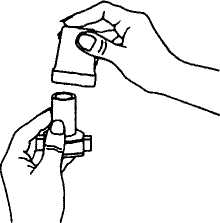
- 1. Remove the protective cap from the inhaler.
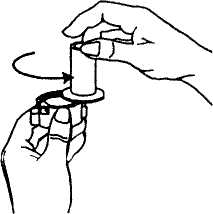
- 2. Hold the base of the inhaler firmly and open the mouthpiece by turning it in the direction of the arrow.

- 3. Then, place the capsule in the compartment in the base of the inhaler.
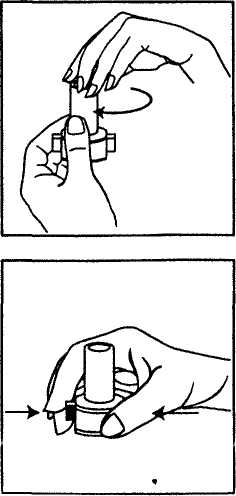
- 4. Turn the mouthpiece to the closed position.
- 5. From now on, hold the inhaler vertically and press the red buttons on the side of the device firmly ONLY ONCE. Release the buttons.
Note: At this point, the capsule may break! Small pieces of hypromellose may enter the mouth and throat during inhalation. Since hypromellose is edible, its consumption is not harmful. The likelihood of such an event is minimal if the capsule is not pierced more than once, storage conditions are maintained, and the capsule is removed from the container only immediately before inhalation.
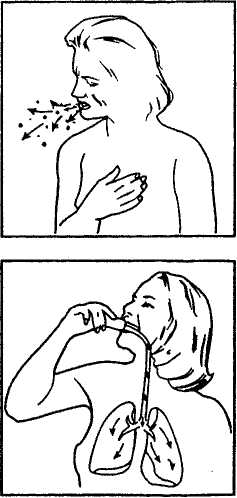
- 6.a) Perform a deep exhalation as quickly as possible (do not do this through the inhaler).
- 6.b) Place the mouthpiece in your mouth and seal your lips around it. Tilt your head back slightly and perform a quick and deep inhalation. As the capsule rotates in the inhaler chamber and the powder is dispersed, a characteristic sound should be heard. If this sound does not appear, it means that the capsule is stuck in the compartment. In this case, open the inhaler and remove the capsule from the compartment. Do not try to remove the capsule from the inhaler by pressing the buttons multiple times.
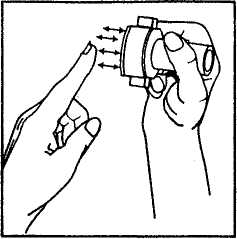
- 6.c) After hearing the characteristic sound, hold your breath for as long as possible. Before performing a slow exhalation, remove the inhaler from your mouth. Then, breathe normally. After use, check if the inhalation was performed correctly. To do this, open the inhaler and check if there is still powder in the capsule. If powder remains in the capsule, repeat the actions described in points (6a) to (6c).
After inhalation
Open the inhaler, remove the empty capsule, turn the mouthpiece to its initial position, and put the protective cap back on.
Cleaning the inhaler
The inhaler should be cleaned with a dry cloth to remove any remaining powder. To do this, open the capsule compartment and remove any remaining powder completely. The mouthpiece should also be cleaned. A clean, soft-bristled brush can also be used for cleaning.
Note:
Oxodil PPH capsules should only be used with the provided inhaler. Under no circumstances should other inhalers be used.
The inhaler intended for Oxodil PPH administration should not be used for inhalation of other medicines.
Recommended dose:
Adults, including elderly patients:
Asthma
Long-term use:1 inhalation once or twice a day. In some patients, it may be necessary to use 2 inhalations once or twice a day.
Prevention of exercise-induced bronchospasm
1 inhalation before exercise.
The daily dose should not exceed 4 inhalations.
Do not use more than 2 inhalations at a time.
Chronic obstructive pulmonary disease (COPD)
Long-term use:1 inhalation once or twice a day.
The regularly used daily dose should not exceed 2 inhalations.
If necessary, to relieve symptoms, additional inhalations can be used, in addition to those used regularly, up to a maximum daily dose of 4 inhalation capsules (including the regularly used doses).
Do not use more than 2 inhalations at a time.
Special patient groups
No dose adjustment is necessary in patients with renal or hepatic impairment.
In the case of switching from another formoterol inhalation product to Oxodil PPH, it may be necessary to adjust the dose.
Using more than 2 doses per day more frequently than twice a week indicates that the treatment is insufficient. In such a case, the doctor will consider changing the treatment.
Using higher doses than recommended does not provide additional benefits, but only increases the risk of side effects, including severe ones.
If you feel that the effect of Oxodil PPH is too strong or too weak, consult your doctor.
Using a higher dose of Oxodil PPH than recommended
Overdose symptoms are the same as side effects, but they may occur suddenly and be more severe.
Overdose symptoms include:
Nausea, vomiting, headache, palpitations, rapid or irregular heartbeat, muscle tremors, especially in the hands, dizziness, anxiety, sleep disturbances, and chest pain.
If such symptoms occur, inform your doctor immediately. The patient may require appropriate treatment.
Missing a dose of Oxodil PPH
Do not use a double dose to make up for a missed dose.
As a rule, making up for a missed dose is not necessary, but if the patient's condition requires it, it can be taken. The time interval to the next scheduled dose should be at least 6 hours.
Stopping Oxodil PPH treatment
Inform your doctor about any interruption in treatment or discontinuation of its use, along with the reason (e.g., due to side effects, etc.).
If you have any further doubts about using this medicine, consult your doctor or pharmacist.
4. Possible side effects
Like all medicines, Oxodil PPH can cause side effects, although not everybody gets them.
In assessing side effects, the following convention has been used to describe their frequency:
Very common:occurring more frequently than in 1 in 10 people;
Common:occurring in 1 to 10 people in 100 people;
Uncommon:occurring in 1 to 10 people in 1,000 people;
Rare:occurring in 1 to 10 people in 10,000 people;
Very rare:occurring less frequently than in 1 person in 10,000 people;
Unknown:frequency cannot be estimated from available data.
The most commonly reported side effects during treatment with β-adrenergic receptor agonists, such as tremors and palpitations, seem to be mild and resolve within a few days of treatment.
There are no very common side effects.
| System organ class | Common | Uncommon | Rare | Very rare |
| Immune system disorders | Hypersensitivity reactions, such as rash, urticaria, itching, angioedema, or peripheral edema | |||
| Metabolic and nutritional disorders | Hypokalemia (potassium deficiency) | Hyperglycemia (elevated blood sugar), increased insulin levels, free fatty acids, glycerol, and ketone bodies in the blood | ||
| Psychiatric disorders | Agitation, anxiety, nervousness, sleep disturbances, excitement, restlessness | |||
| Nervous system disorders | Headache, tremor | Dizziness, taste disturbances | ||
| Cardiac disorders | Palpitations | Tachycardia (rapid heart rate) | Arrhythmias, such as atrial fibrillation, supraventricular tachycardia, extrasystoles | Angina pectoris, QTc interval prolongation |
| Vascular disorders | Changes in blood pressure | |||
| Respiratory, thoracic, and mediastinal disorders | Throat irritation | Severe cough or wheezing | Paradoxical severe bronchospasm |
| Gastrointestinal disorders | Mouth irritation | Nausea | ||
| Musculoskeletal and connective tissue disorders | Muscle cramps, muscle pain |
Lactose contains small amounts of milk proteins and may therefore cause allergic reactions.
Tell your doctor if you experience any side effects. If necessary, your doctor will adjust the dose of the medicine. Do not change the dose without consulting your doctor. If severe side effects occur, stop using Oxodil PPH immediately and inform your doctor.
Reporting side effects
If you experience any side effects, including any side effects not listed in this leaflet, tell your doctor or pharmacist. Side effects can be reported directly to the Department of Adverse Reaction Monitoring of Medicinal Products, Medical Devices, and Biocidal Products
Al. Jerozolimskie 181C
02-222 Warsaw
Phone: +48 22 49 21 301
Fax: +48 22 49 21 309
Website: https://smz.ezdrowie.gov.pl
Side effects can also be reported to the marketing authorization holder.
Reporting side effects will help gather more information on the safety of the medicine.
5. How to store Oxodil PPH
Keep the medicine out of the sight and reach of children.
Do not use this medicine after the expiry date stated on the carton and inhaler. The expiry date refers to the last day of the month.
The inscription after the abbreviation EXP indicates the expiry date, and after the abbreviation Lot, it indicates the batch number.
Store below 25°C.
Store in the original packaging to protect from moisture.
Medicines should not be disposed of via wastewater or household waste. Ask your pharmacist how to dispose of medicines that are no longer needed. This will help protect the environment.
6. Contents of the packaging and other information
What Oxodil PPH contains
- The active substance of Oxodil PPH is formoterol fumarate dihydrate. Each hard capsule contains 12 micrograms of formoterol fumarate dihydrate. Each delivered dose contains 9 micrograms of formoterol fumarate dihydrate.
- The other ingredients are: anhydrous lactose, monohydrate lactose, hypromellose.
What Oxodil PPH looks like and contents of the pack
An HDPE bottle closed with a polypropylene cap containing a desiccant. A plastic inhaler is included in the packaging.
Oxodil PPH is available in packs containing 60, 120, 180, and 240 hard capsules with powder for inhalation and one inhaler.
Marketing authorization holder and manufacturer
Marketing authorization holder:
Polpharma S.A.
ul. Pelplińska 19, 83-200 Starogard Gdański
tel. +48 22 364 61 01
Manufacturer:
SMB TECHNOLOGY SA
39, Rue du Parc Industriel
B-6900 Marche-en-Famenne
Belgium
Polpharma S.A.
ul. Pelplińska 19, 83-200 Starogard Gdański
Other sources of information
A detailed instruction manual for the inhaler is available after scanning the QR code included in the leaflet below with a smartphone. The same information is also available on the website www.instrukcjeoxodil.pl
Date of last revision of the leaflet:
QR
- Country of registration
- Active substance
- Prescription requiredYes
- Manufacturer
- ImporterSMB Technology S.A. Zakłady Farmaceutyczne POLPHARMA S.A.
- This information is for reference only and does not constitute medical advice. Always consult a licensed doctor before taking any medication. Oladoctor is not responsible for medical decisions based on this content.
- Alternatives to Oxodil PphDosage form: Aerosol, 12 mcg/measured doseActive substance: formoterolManufacturer: Chiesi Farmaceutici S.p.A. Chiesi Pharmaceuticals GmbHPrescription requiredDosage form: Powder, 12 mcgActive substance: formoterolPrescription requiredDosage form: Powder, 12 mcg/inh. doseActive substance: formoterolPrescription required
Alternatives to Oxodil Pph in other countries
The best alternatives with the same active ingredient and therapeutic effect.
Alternative to Oxodil Pph in Ukraine
Alternative to Oxodil Pph in Spain
Online doctors for Oxodil Pph
Discuss dosage, side effects, interactions, contraindications, and prescription renewal for Oxodil Pph – subject to medical assessment and local rules.














